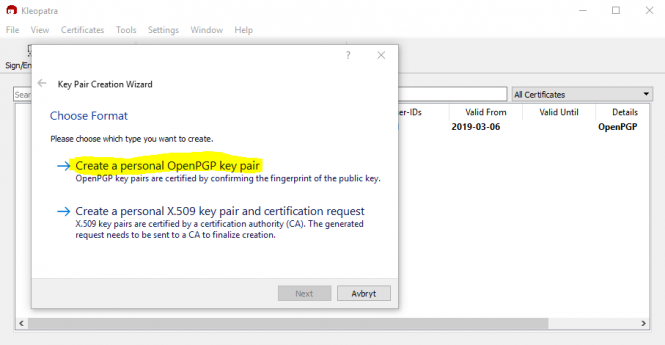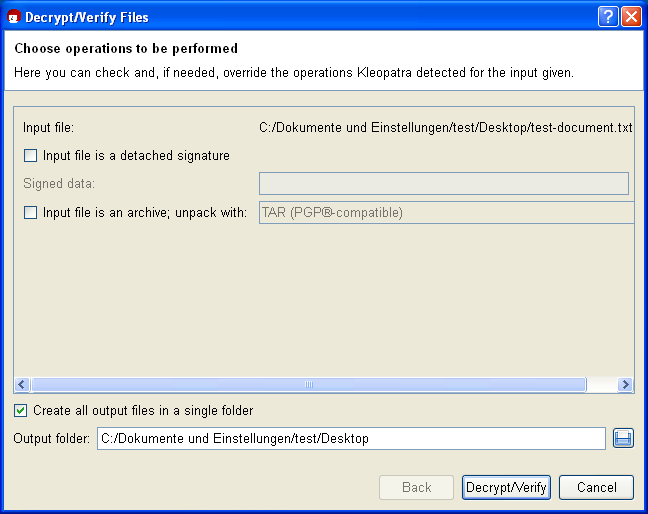
- How to encrype and decryp with gpgwin how to#
- How to encrype and decryp with gpgwin install#
- How to encrype and decryp with gpgwin code#
- How to encrype and decryp with gpgwin password#
I have tried multipl ecombinations of chopgp and bouncycastle versions but no joyĮncrypt-File -fileToEncrypt "C:\Users\me\Downloads\chopgp.1.0.1.3\lib\test.pdf"ĥ | $nameGen = New-Object -TypeName EncryptedFileNameGenerator Is there something obviousl I could be missing?
How to encrype and decryp with gpgwin code#
Hopeing you can help, I've tried your code example above and I can't get it to work, the error suggested the assemblies aren't loaded but I have confirmed that they are.
How to encrype and decryp with gpgwin password#
But when I am decrypting, it is asking for password even though Im using the same code I have used your code for encryption and decryption for PGP files in file server. We can now read that original file like normal! Gpg: WARNING: message was not integrity protected Gpg: keyring `C:/Users/adam/AppData/Roaming/gnupg/secring.gpg' created PS C:\> Remove-Encryption -FolderPath C:\ImportantFiles\ -Password secret The GnuPG utility is creating a keyring if it doesn’t exist yet, decrypting the file, and the Remove-Encryption function is returning the path to the folder that I passed in. You can see below that I’m using the Remove-Encryption command and passing the path of the folder and the secret. This GnuPG utility processes the file by first decrypting it, then creating a file of the same name with the unencrypted contents. Now that the file is encrypted in the GPG file, it can’t be read unless decrypted. Add-Encryption -FolderPath C:\ImportantFiles\ -Password 'secret' At this point, I could just remove the original file if I desired. It returns a GPG file that is the contents of the file encrypted. I’m using the Add-Encryption command, which calls the GnuPG utility under the covers to encrypt this file using the password I’m specifying. You can see below that I have a folder with a single file in it. To do that, I can use the Add-Encryption command that comes with this module by simply using the Add-Encryption command specifying the folder of files I’d like to encrypt as well as the password I’d like use to secure them. Next, I need to encrypt a bunch of important files in a folder with a password only a few other people and I know. This command went out to the GnuPG website, downloaded the installer, and then silently installed it. Handles NPM(K) PM(K) WS(K) CPU(s) Id SI ProcessName PS> Install-GnuPG -DownloadFolderPath 'C:\' Once I download the module, I can see I’ve got a few commands available to me. Invoke-WebRequest -Uri $uri -OutFile (Join-Path -Path $moduleFolderPath -ChildPath 'GnuPg.psm1') $null = New-Item -Path $moduleFolderPath -Type Directory $moduleFolderPath = 'C:\Program Files\WindowsPowerShell\Modules\GnuPg' To do that, I’ll reach out to GitHub and download a module called GnuPG and place it in a module path on my system. Let’s save some time downloading a PowerShell module from GitHub will expedite this process dramatically.
How to encrype and decryp with gpgwin how to#
We could also figure out how to build a PowerShell tool around GnuPG for Windows ourselves, but why do that when a community module already exists? We could go out to the website and do this manually, but we’re using PowerShell! Let’s stick to the command line.
How to encrype and decryp with gpgwin install#
We first need to download and install this.

This free, open-source utility uses the OpenPGP Standard to bring PGP to Windows.

To encrypt and decrypt files on Windows with PGP, we must download the GNU Privacy Guard for Windows utility.


 0 kommentar(er)
0 kommentar(er)
